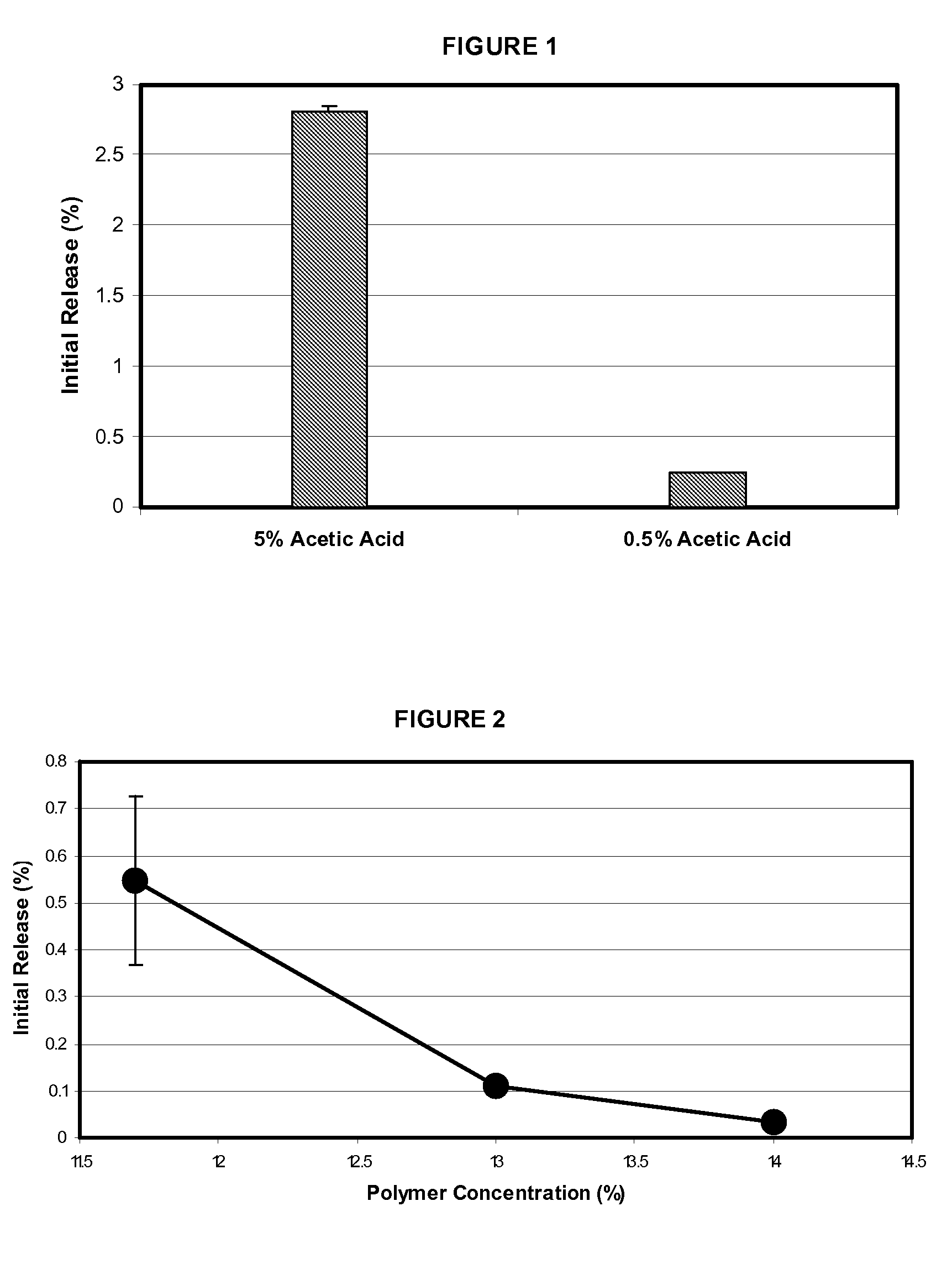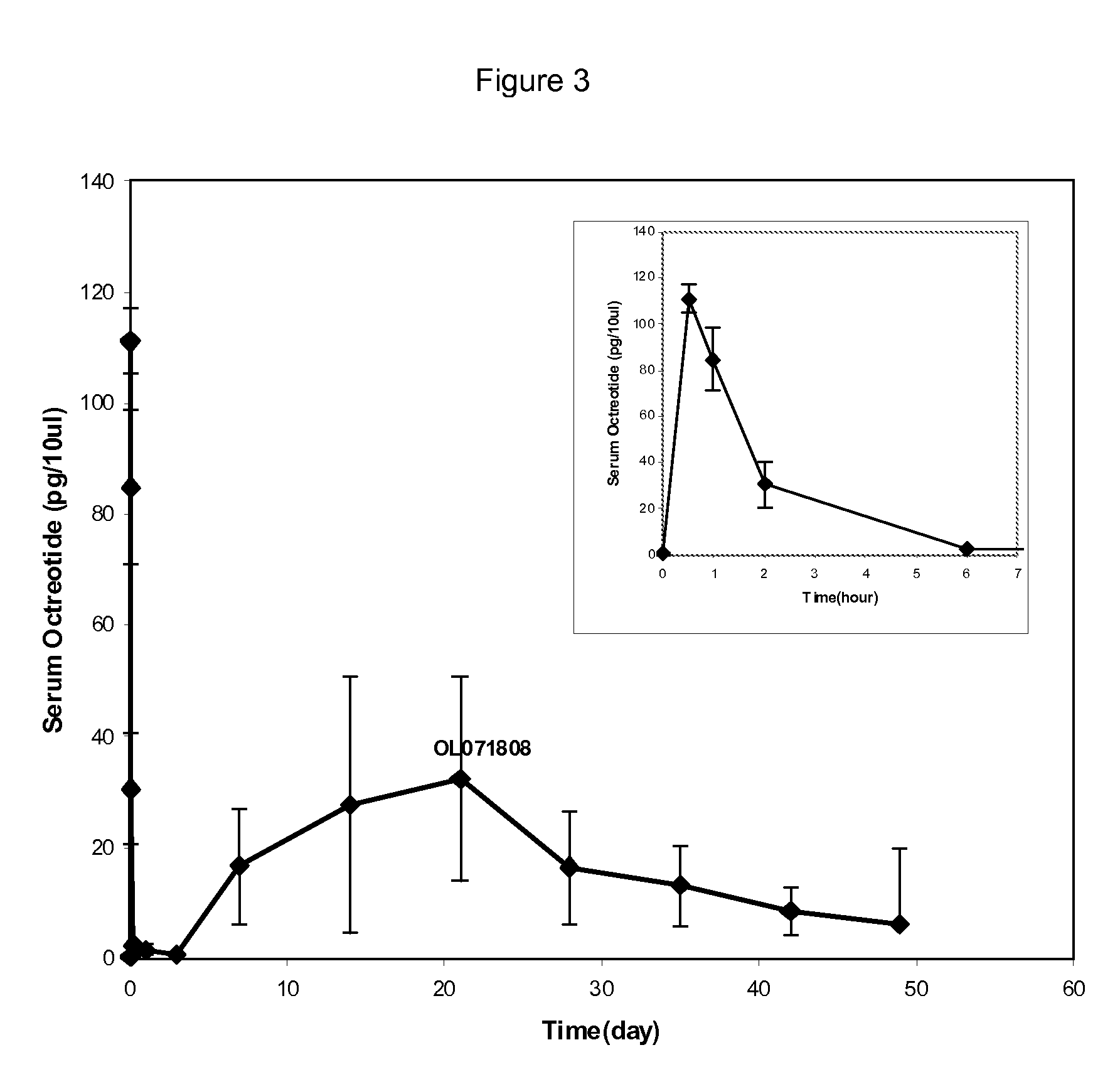Microspheres for the sustained release of octreotide with a low initial burst
a microsphere and octreotide technology, applied in the field of polymer-based drug delivery, can solve the problems of insufficient product dose and eventually reinjection, long suspension time, and clogging of needles during the withdrawal of suspended microspheres, so as to avoid pain in patients, shorten the suspension time, and reduce the effect of suspension tim
- Summary
- Abstract
- Description
- Claims
- Application Information
AI Technical Summary
Benefits of technology
Problems solved by technology
Method used
Image
Examples
example 1
[0054]Octreotide Loaded PLGA Microshperes with High Initial Burst Release
[0055]These octreotide PLGA microspheres were manufactured with about 5% (w / w) glacial acetic acid in the dispersed phase. The microspheres showed about 2.4% initial release within 5 minutes at pH 7 and about 2.8% initial release within 15 minutes at pH 4. Briefly, the microspheres were manufactured as follows. 9.36 g of poly(D,L-lactide-co-glycolide) (PLGA, lactide:glycolide=50:50, inherent viscosity=0.60 g / dL) was dissolved in 63.66 g of dichloromethane to prepare the polymer solution. Separately, 0.76 g of octreotide acetate was dissolved in a mixture of 0.40 g glacial acetic acid and 5.99 g methanol to prepare the octreotide solution. The octreotide solution was added to the polymer solution, and then mixed to prepare a clear and slightly yellow dispersed phase (DP). Separately, 0.35% polyvinyl alcohol was dissolved in purified water and filtered through 0.22 micron PVDF membrane filter. This aqueous soluti...
example 2
[0056]Octreotide Loaded PLGA Microspheres with Low Initial Burst Release
[0057]These octreotide PLGA microspheres were manufactured with about 0.5% (w / w) glacial acetic acid in the dispersed phase. The microspheres showed about 0.14% initial release within 5 minutes at pH 7 and about 0.24% initial release within 15 minutes at pH 4. Based on this initial release, it is expected that the initial release will be less than 1% of a total amount of octreotide acetate at 37° C. and a pH of 7.4. Briefly, the microspheres were manufactured as follows. 9.34 g of poly(D,L-lactide-co-glycolide) (PLGA, lactide:glycolide=50:50, inherent viscosity=0.60 g / dL) was dissolved in 60.64 g of dichloromethane to prepare the polymer solution. Separately, 0.77 g of octreotide acetate was dissolved in a mixture of 0.4 g glacial acetic acid and 6.01 g methanol to prepare the octreotide solution. The octreotide solution was added to the polymer solution, and then mixed to prepare a clear and slightly yellow dis...
example 3
[0058]Octreotide Loaded PLGA Microspheres with Very Low Initial Burst Release
[0059]These octreotide PLGA microspheres were manufactured with about 0.5% (w / w) glacial acetic acid and 14% polymer in the dispersed phase. The microspheres showed about 0.03% initial release within 15 minutes at pH 4. Based on this initial release, it is expected that the initial release will be less than 1% of a total amount of octreotide acetate at 37° C. and a pH of 7.4. Briefly, the microspheres were manufactured as follows. 9.34 g of poly(D,L-lactide-co-glycolide) (PLGA, lactide:glycolide=50:50, inherent viscosity=0.45 g / dL) was dissolved in 51.79 g of dichloromethane to prepare the polymer solution. Separately, 0.76 g of octreotide acetate was dissolved in a mixture of 0.40 g glacial acetic acid and 4.91 g methanol to prepare the octreotide solution. The octreotide solution was added to the polymer solution, and then mixed to prepare a clear and slightly yellow dispersed phase (DP). Separately, 0.35...
PUM
| Property | Measurement | Unit |
|---|---|---|
| inner diameter | aaaaa | aaaaa |
| volume | aaaaa | aaaaa |
| inner diameter | aaaaa | aaaaa |
Abstract
Description
Claims
Application Information
 Login to View More
Login to View More - R&D
- Intellectual Property
- Life Sciences
- Materials
- Tech Scout
- Unparalleled Data Quality
- Higher Quality Content
- 60% Fewer Hallucinations
Browse by: Latest US Patents, China's latest patents, Technical Efficacy Thesaurus, Application Domain, Technology Topic, Popular Technical Reports.
© 2025 PatSnap. All rights reserved.Legal|Privacy policy|Modern Slavery Act Transparency Statement|Sitemap|About US| Contact US: help@patsnap.com



